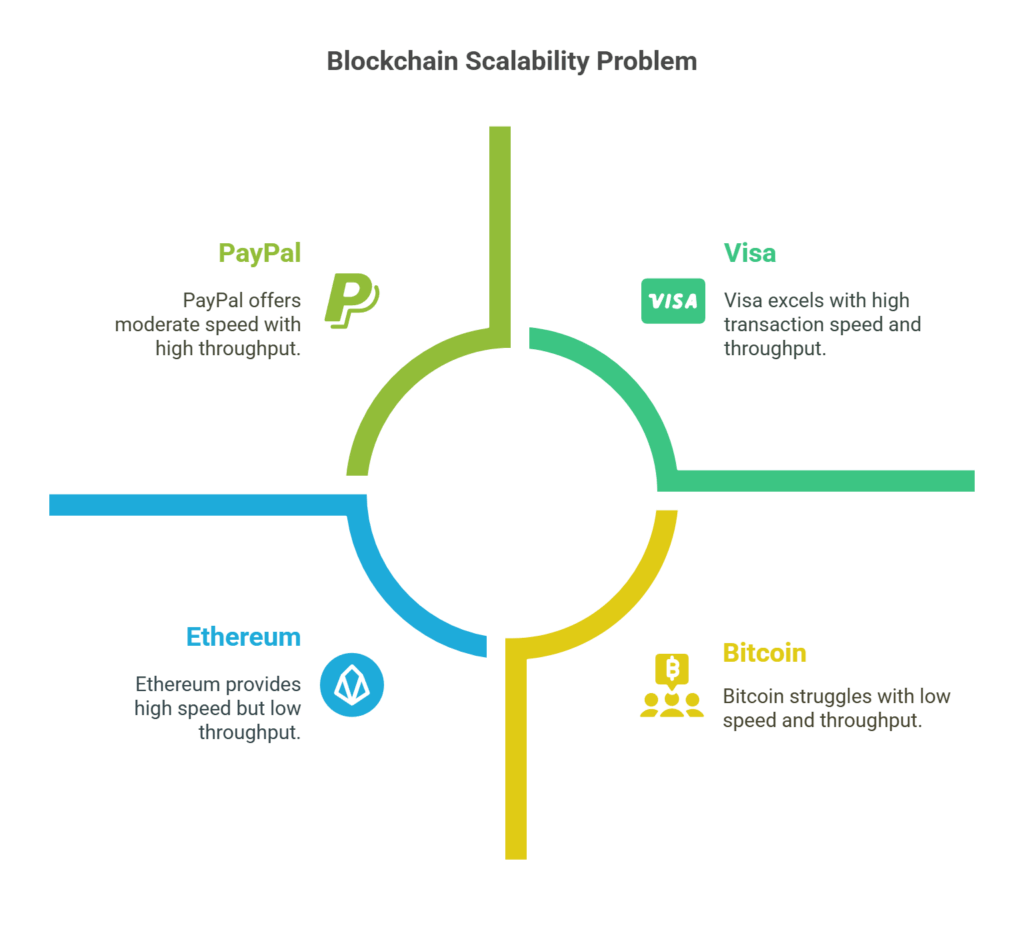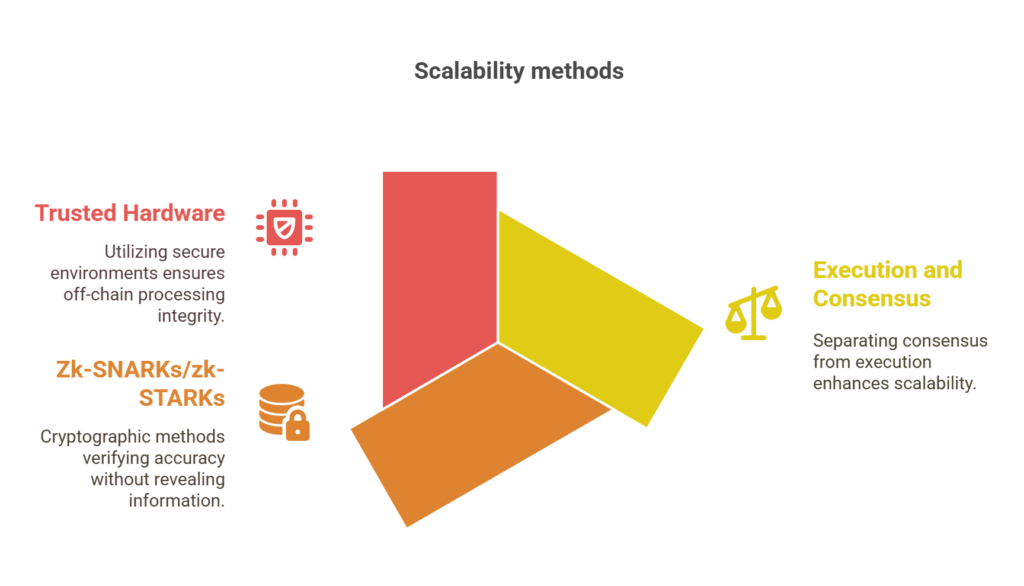Blockchain Scalability
In the context of blockchain, scalability is the capacity of a system to function effectively at all realistic load levels. Transaction timings, transaction rates, node counts, participant and account counts, and other characteristics can all be included in the load. Many applications, especially supply chain management and payment systems, depend on transaction rate (TPS). Scalability is a major issue for Bitcoin and Ether. This prevents blockchain from being widely used in business. Companies often worry if blockchain nodes, networks, infrastructure, and protocols can match credit card transaction rates.
Also Read About Blockchain Performance Metrics, Scalability & Optimization
Blockchain Scalability Problem

Bitcoin and Ethereum struggle to match Visa and Mastercard in transaction speed and latency.
- Bitcoin can currently execute seven transactions per second, but the network can only handle three to seven.
- Ethereum averages 15 transactions per second.
- However, Visa’s payment network can process 24,000 and complete 65,000 transactions per second. About 200 transactions can be processed by PayPal every second.
Public blockchains’ low transaction rate is frequently insufficient for the high-throughput use cases that enterprises need. Congestion is brought on by an increase in the number of issued transactions, which causes transaction commit times to significantly lag. Transactions in the Bitcoin mempool, or pending transaction pool, for instance, could be waiting for hours or even days. This is likewise regarded as a basic issue that must be resolved in order for the Ethereum blockchain to be widely used.
Blockchain scalability issues
The scalability constraints of many blockchains are caused by a number of factors:
Consensus Mechanisms
A key element of a blockchain system, reaching consensus among many participants involves a substantial amount of overhead. Using consensus procedures to add blocks and validate transactions adds time and lowers throughput when compared to centralised systems. For a high number of nodes, scalability is limited by resource-intensive consensus techniques such as Proof of Work (PoW) or even Byzantine Fault Tolerance (BFT). For example, Bitcoin’s PoW-based consensus process can process up to seven or eight transactions every second.
Sequential Processing
Blockchain transactions are typically carried out one after the other. Performance is impacted by this serial processing, which is viewed as a bottleneck.
Block Size and Block Time
The amount of transactions that a block can accommodate and the time needed to confirm a block are the two factors that restrict the transaction pace. A fork is created when the block size is increased, and larger blocks take longer to spread throughout the network, which could lead to more forking problems. It is also not possible to reduce the interval between blocks, which is necessary to avoid excessive forking.
Data Storage and Replication
In a public blockchain network, each node keeps a copy of the complete ledger. The size of this ledger grows as the blockchain does, necessitating a large amount of storage space and making it more challenging for typical computers to function as complete nodes.
Transaction Verification Overhead
To verify the legitimacy of each transaction in a block, every node in the network executes it once. This procedure restricts the quantity of transactions that may be handled and is computationally costly. High transactional throughput might restrict public access by requiring only powerful devices to validate the chain.
Also Read About Enterprise Blockchain: Improves Your Data Security
Scalability in blockchain challenges and solutions
Research and development efforts are focused on finding solutions for blockchain scalability, and a variety of methods and ideas are being considered. In general, approaches fall into one of several categories:
Layer 0 / Network Layer Methods
Methods at the communication level beneath the blockchain protocol itself are referred to as Layer 0 or Network Layer methods.
- Better Network Protocols: Kadcast and bloXroute are two solutions that try to make block and transaction propagation across the network more effective and quick.
- Increased Bandwidth: According to some academics, increasing network speed to the internet’s level can be beneficial because it will speed up block selection and consensus by facilitating the faster relay of transactions and blocks.
Layer 1/On-chain Techniques
These techniques entail improving the blockchain’s fundamental protocol.
- Increasing Block Size: In order to support more transactions per block and possibly boost throughput, there is a contentious proposal to increase the hardcoded block size (for example, 1 MB in Bitcoin). Larger blocks take slower to propagate and demand more storage, which could effect forking, therefore this is not without its challenges.
- Transaction Parallelisation: By building blockchains to carry out transactions in parallel rather than sequentially, performance might be greatly increased without sacrificing security or consistency.
- Sharding: This method divides the network state and processing jobs into smaller units known as “shards” and was taken from distributed databases. Because each shard may handle transactions concurrently, throughput can be increased and node storage needs can be decreased. For instance, sharding is planned for Ethereum 2.0. Inter-shard communication and security threats like single-shard takeover assaults are obstacles.
- Changing Consensus Mechanisms: For big, untrusted networks, using consensus algorithms that are more effective than conventional PoW or BFT can speed up transactions and save energy. Examples include Directed Acyclic Graphs (DAGs), which do not require blocks or mining and enable the construction and confirmation of transactions in parallel, and Proof of Stake (PoS) and its variations (such as DPoS). BFT is one of the more recent consensus methods for permissioned chains, however it might not work well when there are a lot of nodes.
- Private Blockchains: Because they might not need resource-intensive consensus techniques like PoW, permissioned or private blockchains, whose members are known and frequently trusted, can achieve faster transaction rates. Open access and decentralisation are sacrificed in the process, though.
Also Read About What Are The Different Layers In Blockchain Technology
Layer 2/Off-chain and Multichain Techniques
To lessen the strain on the core layer, these techniques conduct transactions off of the main blockchain.
- State Channels: These enable peer-to-peer off-chain transactions between participants, with just the channel’s opening and closing being noted on the main chain. One example of utilising state channels to facilitate quicker and less expensive payments is the Lightning Network of Bitcoin.
- Sidechains are distinct blockchains that are connected to the main chain so that assets can be transferred between them. While trustless sidechains employ technologies like a two-way peg, federated sidechains rely on a trusted group of parties. One example of a federated sidechain is the Liquid Network of Bitcoin.
- Rollups: These Layer 2 solutions post the transaction data into the main chain while carrying out transactions off-chain. This enables the main chain to confirm that the calculations made off-chain are legitimate. ZK Rollups and Optimistic Rollups are two examples. ZK Rollups check execution without re-executing transactions on-chain by using concise proofs.
- Commit Chains, Sub-chains, and Tree Chains: Other ideas include tree chains, which convert the linear blockchain layout to a tree structure, or sub-chains, which join to the main chain for quicker initial verification.
- Multichain Approaches: Platforms such as Cosmos and Polkadot are built as networks of linked blockchains (also known as parachains or zones) that may communicate and function in simultaneously, hence offering scalability and interoperability by nature. Cross-chain message transport is facilitated via Polkadot’s sharding mechanisms.
Also Read About Hyperledger Fabric News: Seamless Upgrade Guide
Execution Scaling and Other Methods

- Distinguishing Execution and Consensus: One essential structural element for scalability may be to divide the consensus mechanism from the command execution process.
- Zk-SNARKs and zk-STARKs confirm zero knowledge: These cryptographic methods allow one side to prove a statement’s accuracy without giving any other information. When used with blockchain, they can swiftly verify off-chain calculations, reducing chain data and node effort.
- Trusted Hardware: To guarantee the integrity of off-chain processing for scalability, some solutions suggest utilising trusted execution environments.
Combining a few of these strategies will probably result in an elegant solution to scaling problems. Considerable research is being done to increase the scalability of blockchain technology.
